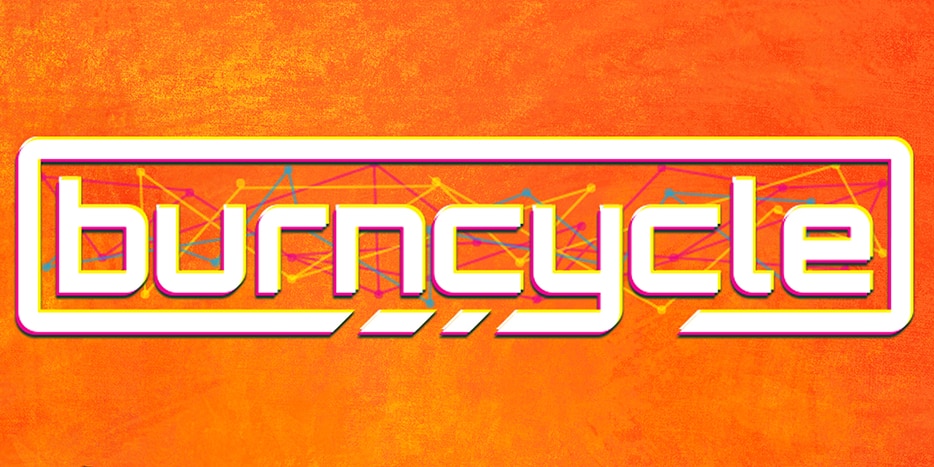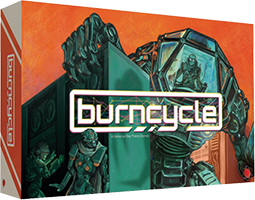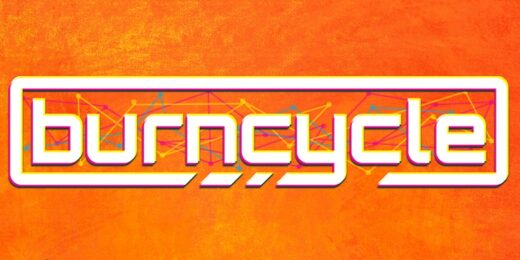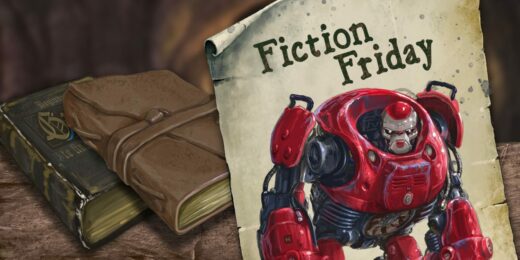Looting the Trove: Behind Burncycle

Welcome to Looting The Trove, a look at the behind-the-scenes development of the games in the CTG library. This month, with burncycle coming to Kickstarter on Nov. 10, we’re taking a look at the origins of the game and some key gameplay elements with CTG co-founder and game designer Josh Carlson.
Josh has had a lot of the basic concepts for burncycle’s game mechanics for years, even predating the publication of Too Many Bones, but he couldn’t match them to the right theme. In 2019, however, he was hit with a flash of inspiration.
“About a year ago is when I spotted some of those classic sci-fi book covers with giant robots towering over defenseless humans, and the idea of a role reversal stuck with me,” he said.
After coming up with the basic idea of good robots vs. bad humans, Josh then applied additional inspiration from video games like Transistor and Fallout (informing the building exploration elements of burncycle) and science fiction stories like The Matrix, Ex Machina and the work of Isaac Asimov.
This process has allowed the themes of the game to integrate seamlessly into the gameplay itself. To keep robots in line, humans have restricted them to a simple code sequence of actions (like physical, tech or utility) that keep them from participating in activities outside their assigned roles — like, say, overthrowing the oppressive human government. To get around the requirements of the code sequencing, bots have developed processes called “burncycles,” which allow them to creatively use the humans’ sequences to accomplish tasks that technically fall under the prescribed code. The bots use these burncycles to infiltrate the most oppressive human corporations on Earth, hoping to regain the autonomy.
“In the game, this action sequencing drives the entire game while keeping it fresh at all times,” Josh explained. “Bots start a round by pooling their allowed actions. Those are placed in a bag, and then five are drawn and locked into the burncycle at random. Bots then have the ability to take turns each performing as many or as few actions from the burncycle in a linear fashion.”
If, for example, your code sequence was action, tech, action, utility, utility, your bot might move, hack into a locked door, move again, access the corporate wireless network, and use a terminal.
“Where you enter and how you use the burncycle will largely determine your success in the game,” Josh said. “While bots are striving to modify and efficiently use every action they can, the human CEO and their security detail are trying to lock those actions down, stall out your progression, or even remove action slots completely. Each round has you working with your team to best use an ever-changing cycle of actions to progress through the game, take down the CEO, and regain an essential piece of AI code.”
Moving through the building is only half the game, however. Robots must also infiltrate a corporate wireless network to gain experience, reduce the bots’ overall threat level, and prevent wireless shutdowns of their companions.
“In a stealth game where patience is a virtue and timing your actions is imperative, we still want every second in the game to matter,” Josh said of the network’s inclusion. “Even while hiding behind a plastic ficus plant in a conference room, you can still be useful to your team!”
One of the most exciting parts of burncycle for Josh is its ability to be broken into discrete chunks. Each individual game is split up into multiple floors. You could spend 45 minutes to an hour on a single floor and return to the next floor when you have time, or you could do all three floors in a single sitting. Josh’s favorite way to play is the campaign mode, which takes you through every HQ while still being accessible to play in whatever size chunk best suits your needs.
“Once you’ve taken down a CEO, you are granted the special action they were safeguarding,” he said. “This action is mixed in with your future burncycle actions and grants every player new and unique options when facing the remaining CEOs. However, you aren’t just facing a CEO. You are also facing the security detail they have hired. And if you happen to face the same security team you faced previously, they come back harder.”
Campaigns are also extremely variable. During the course of your missions, you can free additional bots to add to your team, and since objectives, guards and security commanders are randomized, your next playthrough will always be different.
“This is turning into one of the more surprising and rewarding games I’ve worked on,” Josh said. “We’ve never had as capable a team as we do now, and not having to scramble to change my role from graphic designer to video editor to co-owner to game designer has been very refreshing and maybe even more fulfilling when I see others taking hold of a vision and making it notably better! It’s been a great reminder of how collaborative game design is, and this team is firing on all cylinders.”







